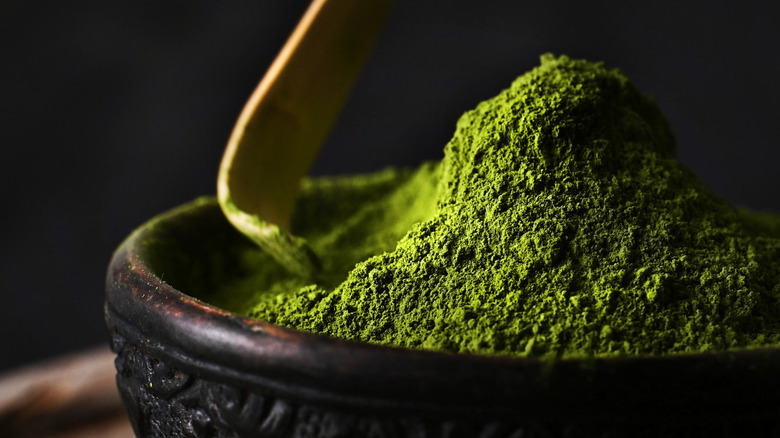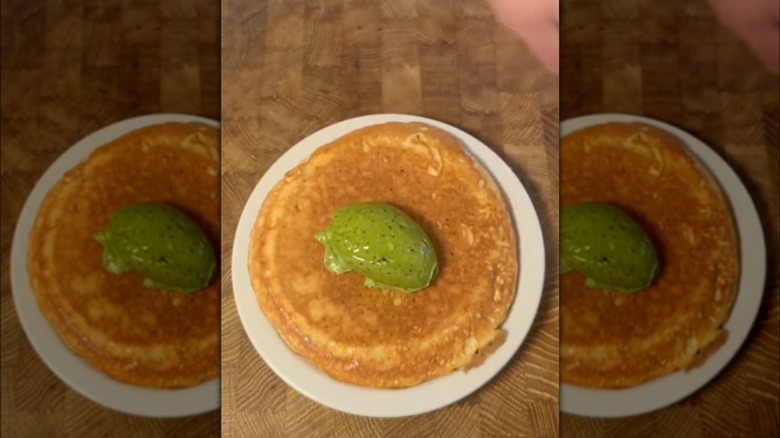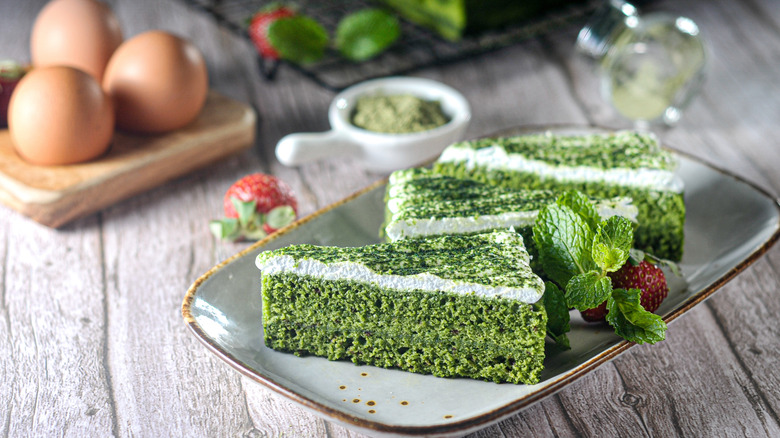Your Butter Needs A Boost From Matcha Powder
Along with other essentials like sugar, flour, eggs, and bread, a tub or stick of butter is a must-have kitchen staple that's been enjoyed for thousands of years across many civilizations. As its role in cooking and baking has evolved, so has its flavor. From vegan varieties to grass-fed selections and clarified ghee, butter is more than just a spreadable, savory dairy product. Compound butter, for example, is regular butter that's been threaded with added ingredients to change its taste, and sometimes, texture. While utilitarian herbs, spices, and seasonings like garlic, salt, and rosemary are some of the obvious choices, matcha-infused compound butter is a must-try.
Although matcha is typically enjoyed in beverages, it works just as well in food recipes. Matcha is often pigeonholed as a tea with a singular, grassy flavor. However, it actually exists within a wide spectrum of flavors. Some matcha powders flaunt notes of toasty rice while others have an umami-forward bravado; matcha can be sweet, savory, and even citrusy. By selecting a matcha powder that speaks to your senses and blending it with your favorite butter, you give the spread new layers of nuanced depth and complexity. When combined with sugar, matcha butter is an exciting addition to pastries and other sweet treats. Without sugar, matcha butter can work just as well in savory recipes. Whether you opt for one of the many brands of store-bought butter or a scratch-made batch, matcha powder is a culinary secret weapon.
Making matcha-infused butter
To make this tea-tinted butter, all you need to do is pulse butter, matcha powder, and any other complementary ingredients that your taste buds desire in a food processor until everything is fully blended. Consider sifting the matcha into the butter to prevent clumping. You can also whisk or simmer the matcha in hot water to give it that latte-ready, silky-smooth texture, but be mindful of how the added moisture might affect any rigid recipe ratios.
Ceremonial-grade matcha is best for sipping, but culinary-grade varieties are best for cooking and baking. Culinary-grade matcha powder has a bigger flavor with fewer nuances, which helps its flavors emerge and stand out among the other ingredients in many of your favorite recipes. It's also worth noting that culinary-grade matcha tends to be more affordable than its ceremonial counterpart, so you won't have to break the bank to make this green butter.
Uses for matcha-infused butter
Matcha butter is an adventurous provision you don't see in everyone's kitchens. Luckily, there are plenty of ways to put matcha butter to good use, both savory and sweet. Start your day with a warm cup of matcha and a heaping bowl of oatmeal topped with matcha butter. Top with pistachios, coconut flakes, and dark chocolate, and enjoy a heavenly, sweet, yet nutrient-dense morning meal. For something more indulgent, smother a stack of buttermilk pancakes with matcha butter and drown it in maple syrup for a warming, earthy take on a classic dessert breakfast. Leverage the tea-kissed butter to make brownies or use it to garnish freshly baked croissants, letting it melt into their flaky folds, releasing its matcha-forward flavors as it oozes across the pastry.
Make savory muffins with zucchini, squash, carrots, and a touch of spicy ginger before topping them with matcha butter for a complex, garden-fresh taste that's equal parts warming and uplifting. Sautee garlicky shrimp in matcha butter and serve over rice for a rustic, allium-centric, fish recipe that's teeming with subtleties. And when all else fails, throw a slice of whole-grain bread into the toaster, and lather it with matcha butter for a simple yet satiating bite.
Once you master the art of matcha butter, try preparing a compound butter for a juicy steak. After all, why eat regular butter when you can jazz it up with bigger, bolder, and brighter flavors?


